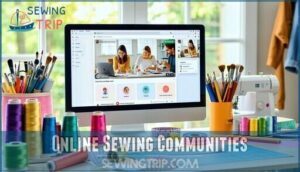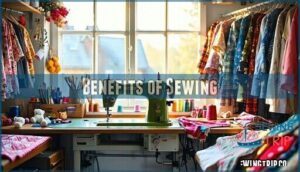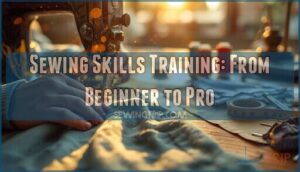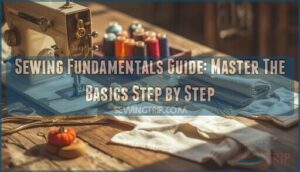This site is supported by our readers. We may earn a commission, at no cost to you, if you purchase through links.
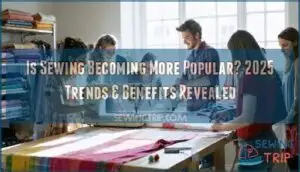
You’re witnessing a remarkable shift as 30 million Americans now sew, with younger generations leading the charge.
TikTok showcases nearly 3 million posts with sewing-related hashtags, proving this isn’t your grandmother’s hobby anymore.
The pandemic sparked interest in self-sufficiency, while sustainability concerns drive people away from fast fashion.
Online communities make learning accessible, and influencers showcase stunning handmade pieces that rival designer brands.
Economic pressures also fuel the trend—creating custom clothing costs less than buying quality pieces.
This renaissance combines traditional skills with modern technology, creating opportunities that extend far beyond simple repairs.
Table Of Contents
Key Takeaways
- You’re witnessing a massive revival – 30 million Americans now sew, with online pattern sales jumping 25% since 2019 and tutorial searches doubling from 2020 to 2023.
- Younger generations are driving the trend – Millennials and Gen Z make up 60% of new sewers, sharing nearly 3 million sewing posts on TikTok alone.
- Multiple motivations fuel growth – You’ll find people sewing for sustainability reasons, cost savings, creative expression, and the therapeutic benefits that reduce stress by 73%.
- Technology is transforming the craft – You can now access digital communities, AI-powered sewing machines, and online tutorials that make learning more accessible than ever before.
Sewing Trends Today
You’re witnessing a remarkable transformation in the crafting world as sewing experiences its biggest comeback in decades, with online pattern sales jumping 25% since 2019.
Sewing’s spectacular revival proves creativity and craftsmanship never go out of style.
Today’s sewing landscape thrives through digital communities, hands-on workshops, and influential content creators who make this traditional skill accessible to a new generation of makers.
Online Sewing Communities
Everyone’s connecting through online platforms that foster sewing community growth.
You’ll find Pattern Sharing sites where sewers exchange designs, while Project Showcases inspire creativity.
Online Tutorials make Skill Development accessible to beginners.
These communities streamline Fabric Sourcing through group purchases and reviews.
Many sewers now utilize digital fabric retailers for convenience.
This digital hub fuels the sewing resurgence, making sewing as a hobby more approachable than ever.
Sewing Classes and Workshops
Local workshops are driving the sewing resurgence by offering hands-on learning experiences.
These classes cater to various skill levels, from sewing for beginners to advanced techniques.
Workshop costs vary by location and class curriculum complexity.
Many resources are available for purchasing sewing supplies.
- Beginner classes focus on basic stitches and simple projects
- Intermediate workshops teach pattern reading and garment construction
- Advanced sessions cover tailoring and specialized techniques
- Online options provide flexible scheduling for busy learners
Teacher qualifications guarantee quality instruction in this growing trend.
Sewing Bloggers and Influencers
You’ll find sewing influencers driving sewing popularity through content creation and brand partnerships across platforms like Instagram and YouTube.
These creators build engaged communities around niche specialization, from vintage patterns to sustainable fashion. Their monetization strategies include sponsored posts, pattern sales, and affiliate marketing.
Community engagement remains essential as followers seek authentic advice and tutorials. Many turn to a sewing advice blog for expert tips.
This influencer-driven movement transforms sewing from a traditional hobby into a trendy, accessible craft that attracts younger demographics to the growing sewing market.
Is Sewing Becoming Popular
Absolutely, sewing is experiencing a remarkable resurgence that’s reshaping the entire sewing industry.
The handmade popularity surge has transformed sewing from a forgotten skill into a thriving hobby, with approximately 30 million Americans now participating.
This sewing popularity boom isn’t just numbers—it’s a cultural shift driven by younger generations discovering DIY fashion through social media platforms.
TikTok alone hosts nearly 3 million sewing-related posts, proving that sewing trends have gone viral.
The pandemic accelerated this movement as people sought creative outlets and embraced sustainable sewing practices.
The surge in interest even led to a sewing machine shortage during the pandemic.
Online sewing pattern sales jumped 25% between 2019 and 2024, while Google searches for sewing tutorials doubled from 2020 to 2023.
The sewing market is responding with innovation—the global sewing machine industry is projected to reach $7.26 billion by 2029.
This growth reflects how sewing as hobby has evolved from necessity to self-expression, attracting creators who value customization and eco-friendly alternatives.
Benefits of Sewing
You’ll discover that sewing offers powerful benefits beyond creating beautiful garments and home décor items.
These advantages range from mental health improvements to significant cost savings that make this craft increasingly attractive to modern makers, with benefits including cost savings.
Therapeutic Benefits of Sewing
Since sewing involves repetitive stitching motions, you’ll naturally enter a mindfulness practice that lowers your heart rate and blood pressure.
This therapeutic hobby reduces stress by 73% and decreases dementia risk while boosting cognitive function.
The focused hand movements develop fine motor skills as endorphins release, creating mental wellbeing through meditative concentration on sewing projects.
Sewing can also provide a boost in self-esteem through creating unique, personalized items.
Eco-Friendly and Financial Benefits
Beyond environmental benefits, sewing delivers impressive cost savings.
You’ll reduce waste while building valuable skills through DIY fashion projects.
- Sustainable Fabrics: Choose organic cotton and bamboo to minimize environmental impact
- Repairing Clothes: Extend garment life through mending and alterations instead of replacing
- Cost Savings: Create quality pieces for less than retail while learning to sew
Sewing tutorials and sewing patterns guide your waste-reducing journey.
These sewing projects transform how you approach fashion consumption.
Creative Expression and Personalization
Sewing transforms mere fabric into custom clothing that reflects your personality.
You’ll create unique designs through DIY fashion projects, turning textile art into wearable expressions.
Learn to sew using tutorials and patterns for upcycling projects that breathe new life into old garments.
Sewing crafts let you design pieces that fit your body perfectly while showcasing your individual style through color and pattern choices, allowing you to express your personality through custom clothing.
Sewing Challenges and Solutions
While sewing popularity soars with a 25% increase in online pattern sales and doubled tutorial searches, you’ll still face real challenges that can slow your progress.
From struggling to judge fabric quality online to finding fewer local fabric shops, these obstacles have practical solutions that keep your sewing journey on track, with solutions to overcome challenges like local fabric shops.
Difficulty in Assessing Fabric Quality
You’ll find evaluating fabric quality online tricky without touching the material first. Check fabric texture descriptions carefully – smooth, well-spun fibers indicate better quality.
Look for detailed weave density information and fiber content listings. Study color accuracy in product photos, though monitors vary.
Ask about drape quality in reviews. Understanding fabric surface characteristics is key to predicting a fabric’s suitability.
These sewing tips help you develop better sewing skills when shopping remotely.
Limited Options for In-Person Fabric Shopping
Fabric store closures hit hard during recent years.
You’ll face fewer chances to assess fabric feel before buying.
Most sewing machine enthusiasts now shop online for materials.
This shift creates fabric sourcing challenges for DIY sewing projects.
Supporting local shops helps preserve hands-on shopping experiences.
Online fabric alternatives can’t replace tactile testing for your sewing techniques and skills development.
Future of Sewing Industry
You’re witnessing a sewing renaissance that’s reshaping the entire industry from career paths to cutting-edge technology.
The future holds exciting opportunities as traditional craftsmanship meets modern innovation, creating new ways to learn, work, and create.
Sewing as a Career Option
Your sewing skills can become a thriving Sewing Business through various paths.
Custom Creations and Alteration Services offer steady income streams, while Design Entrepreneurship lets you build your brand.
You might become a Textile Artist creating unique pieces for galleries or teach diy sewing techniques.
Modern sewing machine technology and advanced sewing techniques open doors to technical textile careers, combining traditional craftsmanship with innovation.
Aspiring professionals can also explore vocational sewing programs for focused training.
Impact of Social Media on Sewing Trends
Social media’s influence reshapes how sewing traditions travel across cultures, creating global tourism experiences around local textile crafts.
Sewing Influencers showcase Viral Patterns through Online Tutorials, driving Community Engagement that spans continents.
Digital Marketing connects makers to authentic cultural experiences, turning traditional techniques into travel destinations worldwide, leveraging Digital Marketing and Community Engagement.
Emerging Technologies in Sewing and Embroidery
Beyond traditional threads and needles, cutting-edge technology is revolutionizing your sewing experience.
Smart Sewing Machines now feature AI Pattern Design that automatically adjusts stitches for perfect results.
Digital Embroidery Tools streamline complex designs, while 3D Printed Fabrics offer unlimited creative possibilities.
Taiwan’s innovation hubs are developing Wearable Tech Integration, merging fashion with technology.
These modern advances make sewing more accessible and precise than ever.
Frequently Asked Questions (FAQs)
What is the future of sewing?
Picture threads weaving through smart fabrics and 3D-printed designs.
You’ll see sewing evolve into high-tech crafting with AI pattern creation, sustainable materials, and digital communities connecting makers worldwide for collaborative innovation.
Is sewing becoming a lost art?
No, sewing isn’t becoming a lost art. You’re witnessing a revival! Online pattern sales jumped 25% since 2019, while tutorial searches doubled. The pandemic sparked renewed interest in handmade skills.
When did sewing become less popular?
You’ll trace sewing’s decline to the mid-20th century when mass-produced clothing became affordable and convenient.
The 1950s-60s marked the shift as department stores expanded and home economics classes disappeared from schools.
What is the most profitable thing to sew?
You’ll profit most from bags, quilts, and home décor items.
They use fabric efficiently, command higher prices, and tap into steady demand.
Bags especially offer great margins with minimal waste.
What age groups are driving sewing popularity?
Like a fresh thread catching diverse hands, younger generations are weaving sewing back into mainstream culture.
You’ll find millennials and Gen Z leading this revival, with 60% of new hobbyists being under 35 years old in recent surveys.
How much does starting sewing typically cost?
Starting sewing typically costs $100-300 initially. You’ll need a basic machine ($80-200), fabric scissors ($15-25), pins, measuring tape, and seam ripper. Add thread, needles, and beginner fabric for practice projects.
Which sewing machines work best for beginners?
You’ll want starter-friendly machines like Brother XM2701, Singer Start 1304, or Janome Look for automatic threading, adjustable stitch length, and clear instruction manuals to build your confidence quickly.
What basic skills should new sewers learn?
Learn hand sewing first – straight stitches, backstitches, and hemming.
Master your machine’s basic functions, practice seam allowances, measuring accurately, and pressing seams properly.
Start with simple projects before tackling complex patterns.
How long does learning to sew take?
Basic sewing skills develop in 2-3 months with regular practice. You’ll master straight seams and simple projects first. Advanced techniques like tailoring take 1-2 years of consistent learning and practice.
Conclusion
Despite thinking sewing’s just for crafty grandmothers, you’re witnessing a cultural shift that’s reshaping fashion and creativity.
The evidence clearly shows is sewing becoming more popular isn’t just a question—it’s reality.
You’ll find 30 million Americans now embrace this skill, driven by sustainability concerns and economic benefits.
Technology enhances traditional techniques while social media spreads inspiration globally.
Whether you’re seeking therapeutic benefits, environmental impact, or creative expression, sewing offers practical solutions for modern challenges you face daily.
- https://www.klove.com/news/fun-unusual/millions-of-us-are-having-fun-sewing-even-in-the-digital-age-54546
- https://welikesewing.com/articles/sewing-and-the-pandemic/
- https://craftindustryalliance.org/pandemic-year-drives-popularity-of-hand-sewing/
- https://www.diversitech-global.com/post/the-impact-of-social-media-on-diy-craft-kit-popularity
- https://homepros.news/u-s-vocational-schools-see-second-year-of-double-digit-growth/

